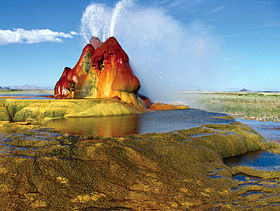Fly Geyser, also known as Fly Ranch Geyser is a small geothermal geyser located on private land in Washoe County, Nevada, about 20 miles (32 km) north of Gerlach. Fly Geyser is located near the edge of Fly Reservoir in the Hualapai Geothermal Flats and is approximately 5 feet (1.5 m) high by 12 feet (3.7 m) wide, counting the mound on which it sits.

In June 2016, the non-profit Burning Man Project purchased the 3,800 acres (1,500 ha) Fly Ranch, including the geyser, for $6.5 million. The Burning Man Project began offering limited public access to the property in May 2018. The geyser contains thermophilic algae, which flourish in moist, hot environments, resulting in multiple hues of green and red, coloring the rocks.
Location
Fly Geyser is located on the Fly Ranch in Hualapai Flat, about 0.3 miles (0.48 km) from State Route 34 and about 25 miles (40 km) north of Gerlach, Nevada. It is due east of Black Rock Desert.
Origin
The source of the Fly Geyser field’s heat is attributed to a very deep pool of hot rock where tectonic rifting and faulting are common.
The first geyser at the site was formed in 1916 when a well was drilled seeking irrigation water. When geothermal water at close to boiling point was found, the well was abandoned, and a 10–12-foot (3.0–3.7 m) calcium carbonate cone formed.
In 1964, a geothermal energy company drilled a second well near the site of the first well. The water was not hot enough for energy purposes. They reportedly capped the well, but the seal failed. The discharge from the second well released sufficient pressure that the original geyser dried up. Dissolved minerals in the water, including calcium carbonate and silica, accumulated around the new geyser, creating the cones and travertine pools.
The geyser has multiple conic openings sitting on a mound: the cones are about 6 feet (1.8 m), and the entire mound is 25 to 30 feet (7.6 to 9.1 m) tall.
Characteristics
The temperature of the water exiting the geyser can exceed 200 °F (93 °C), which is typical for geysers at high elevation.
Carolina Muñoz Saez, who was hired by the Burning Man owners to study the geyser, reported that the geyser contains “a really high amount of silica.” The silica combined with the temperature has caused quartz to form inside the geyser extraordinarily quickly. Quartz typically takes up to 10,000 years to develop in geysers. Saez said the Fly Geyser is unlike any other geyser she has studied.
Water is constantly released, reaching 5 feet (1.5 m) in the air. The geyser has formed several travertine terraces, creating 30 to 40 pools over an area of 74 acres (30 ha). The water produced by the geyser contains thermophilic algae, which flourish in moist, hot environments, coloring the rocks with brilliant hues of green and red.
The Fly Geyser is located on Fly Ranch, a 3,800-acre parcel of land in Northern Nevada purchased by the Burning Man Project in 2016. It is an amazing site that is located about two hours north of Reno, on the edge of the Nevada Black Rock Desert.
The first geyser on the site began to form in 1916 when residents were seeking irrigation water and drilled a well. This well was quickly abandoned when it was discovered that the water inside was too hot, and so began the development of the first geyser. Similarly, the main geyser was created accidentally in 1964 after a geothermal power company drilled a test well at the site. According to later newspaper reports, the well was either left uncapped or was improperly plugged. In either case, the scalding hot water shot from the well hole and calcium carbonate deposits began to form, growing several inches each year.
Jump forward several decades, and those deposits have become three large mounds that rise out of a field of tall reeds and grasses. The sediments are now almost 6 feet tall and are multi-colored green and red. The geyser’s trio of travertine cones still spew scalding hot water about four or five feet into the air. Scientists who are familiar with the geyser note that the coloring on the outside of the mounds is the result of thermophilic algae, which flourishes in moist, hot environments.
The inside of the mounds even contain quartz, according to Muñoz Saez, and this quartz is growing much more rapidly than any of the other geysers that she has studied in her career. Typically, quartz doesn’t begin to grow for about 10,000 years within geysers, which makes the Fly Geyser even more of a marvel.


